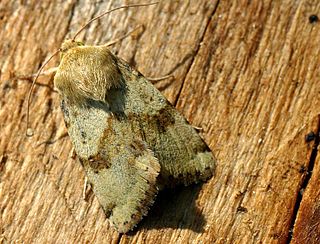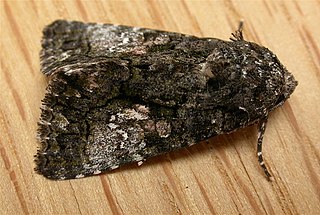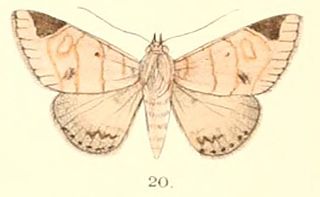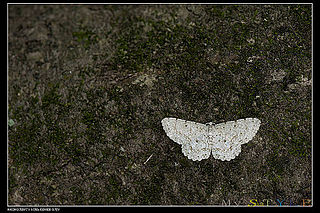Related Research Articles
Ochmastis is a genus of moth in the family Gelechiidae. It contains the species Ochmastis chionacma, which is found in southern Burma.

Heliothis viriplaca, the marbled clover, is a moth of the family Noctuoidea. It is found in Europe and across the Palearctic to Central Asia then to Japan, Korea and Sakhalin. In the south, it penetrates to Kashmir and Myanmar. As a migratory moth, it also reaches areas in northern Fennoscandia in some years. North of the Alps, both indigenous and immigrant individuals occur in certain areas. The heat-loving species occurs mainly on dry grasslands, fallow land, heathlands and sunny slopes and slopes and the edges of sand and gravel pits.

Caradrina clavipalpis, the pale mottled willow, is a moth of the family Noctuidae. The species was first described by Giovanni Antonio Scopoli in his 1763 Entomologia Carniolica. It is found in the Palearctic realm. It is an introduced species in North America, where it was first reported from Queens in New York City in 1993. In 2009 it was found in Rochester, New York, so it appears to be established and spreading.

Aedia leucomelas, the eastern alchymist, sweet potato leaf worm or sorcerer, is a moth of the family Noctuidae. It is found in large parts of the world, ranging from Europe all over Asia up to Japan and some African countries. The subspecies Aedia leucomelas acronyctoides is found in Australia.

Dordura is a monotypic moth genus of the family Noctuidae erected by Frederic Moore in 1882. Its only species, Dordura aliena, was first described by Francis Walker in 1865. It is found in the Indian subregion, Sri Lanka, Myanmar, Thailand, Peninsular Malaysia, Sumatra, Borneo and New Guinea.

Hulodes caranea is a species of moth of the family Erebidae first described by Pieter Cramer in 1780. It is found from India, Sri Lanka, Myanmar, Java, Hong Kong to Queensland and New Guinea, it is also found on the Marianas and Carolines.

Chalciope mygdon, the triangular-striped moth, is a moth of the family Noctuidae. The species was first described by Pieter Cramer in 1777. It is found from the Oriental region to Sundaland.

Leucania loreyi, the cosmopolitan, false army worm or nightfeeding rice armyworm, is a moth of the family Noctuidae. It is found in most of African countries, the Indo-Australian subtropics and tropics of India, Sri Lanka, Myanmar, the eastern Palearctic realm, and the Near East and Middle East. The species was first described by Philogène Auguste Joseph Duponchel in 1827.
Digama hearseyana is a moth of the family Erebidae described by Frederic Moore in 1859. It is found in India, Nepal, Sri Lanka and Pakistan. Two subspecies are recognized.
Dichomeris acuminata, the alfalfa leaf tier, is a moth of the family Gelechiidae. It was first described by Otto Staudinger in 1876. It is a widely distributed species, being known from India, Myanmar, and Sri Lanka southwest to the Seychelles, Mauritius and Réunion and on to Egypt, east and South Africa and southern Europe. Eastward from India it extends through Indonesia and Malaysia to Taiwan and Australia. It is also found in Japan, the West Indies, North America and Hawaii.

Tiracola plagiata, the cacao armyworm, is a moth of the family Noctuidae. The species was first described by Francis Walker in 1857. It is found from south-east Asia, South India, Sri Lanka, Myanmar to the South Pacific Islands, including the northern two-thirds of Australia.

Organopoda carnearia is a species of moth of the family Geometridae. It is found in Japan, Indonesia, Sri Lanka and Taiwan.

Europlema desistaria is a species of moth of the family Uraniidae first described by Francis Walker in 1861. It is found in India, Sri Lanka, Myanmar, Thailand, Taiwan, Borneo, Sulawesi, Flores and Queensland.

Gesonia obeditalis is a species of moth of the family Noctuidae first described by Francis Walker in 1859. It is found from eastern Africa, the Seychelles, the Maldives and the Oriental tropics of India, Sri Lanka east to the Philippines, the Sula Islands and Australia. The adult moth has brown wings with a scalloped dark brown band near the margin. The hindwings are similar in pattern to the forewings but are a paler shade of brown.

Polydesma umbricola, the monkeypod moth or large tabby, is a species of moth in the family Erebidae. The species is found in southern Europe, Africa, Asia Minor to southern Asia, of India, Sri Lanka, Maldives, the Andaman Islands, including many Indian Ocean islands, like Coëtivy Island, Aldabra, Assumption Island, Madagascar and on Hawaii.

Phazaca theclata, the cotton leaf roller, is a moth of the family Uraniidae. It was first described by Achille Guenée in 1858. It is known from Africa south of the Sahara, from Saudi Arabia, as well as from India, Japan, Myanmar, Nepal and Sri Lanka.

Eois grataria is a moth in the family Geometridae. It is found in the Indian subregion, Sri Lanka, Hong Kong, Sundaland and on Christmas Island.
Culladia admigratella is a moth in the family Crambidae. It was described by Francis Walker in 1863. It has a wide range in the tropics, and has been recorded from the British Indian Ocean Territory, Kenya, Malawi, Mauritius, Nigeria, the Seychelles, Sierra Leone, Socotra, India, Myanmar, the Philippines, Sri Lanka and Sumatra.

Catoria sublavaria is a moth of the family Geometridae described by Achille Guenée in 1857. It is found in the tropics of India, Sri Lanka, Myanmar, towards New Guinea, to the Bismarck Islands and Taiwan.
Paragnorima fuscescens is a moth in the family Drepanidae. It was described by George Hampson in 1893. It is found in India, Nepal, China, Vietnam, Thailand and Myanmar.
References
| This article relating to the family Stathmopodidae is a stub. You can help Wikipedia by expanding it. |